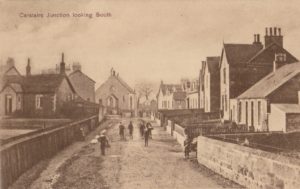Carstairs
Walter the Steward was granted lands here. Anglo-Norman skilled workers were brought to work on the estate, and they remained as settlers. Lands were also granted to the Bishops of Glasgow (including the town and Barony) in the 12th Century, hence the castle at Columbie. Remains of the first church built by early Bishops of Glasgow have been discovered, including the apse (which was wrongly thought to have belonged to a Roman bath); artifacts from this building can be seen in the current Church and grounds, and at Monteith House (mostly pieces of sculpted stone). More recently, the remains of two fonts were found, these have been placed in Lanark Museum. The Barony of Carstairs returned to the Crown in 1587. The families of Lockhart and Fullerton were to own the estate in turn.
In 1756 Carstairs became a Burgh of Barony, and Henry Monteith (the estate’s owner from 1819) planned and reconstructed the settlement. Monteith built a mansion, still standing today, now known as Monteith House (south-west of the Village); this was built on the site of a house constructed by the Fullerton Family, which was demolished in the early 1800s.
Carstairs’ part in Scotland’s story did not cease with the demise of Robert Wishart. It was one of the parishes that petitioned against the Act of Union during the year of 1706.
Narrow by year:
Narrow by tags:
Carstairs Junction looking South
postcardThis is a postcard looking South down Strawfrank Road, Carstairs Junction. The road does not look in good shape in this picture. Also, one of two of the children have…
Strawfrank Road
postcardThis is a nice view of Strawfrank Road, Carstairs Junction which runs parallel to the railway line. The card is sent to Jessie Hutson on May 12th, 1905, when she…
The Carstairs Story
articleThe book, McCallum’s Clydesdale, was written in 1924. It is a mine of useful information and a special chapter is devoted to Carstairs. In his book McCallum describes how he…




